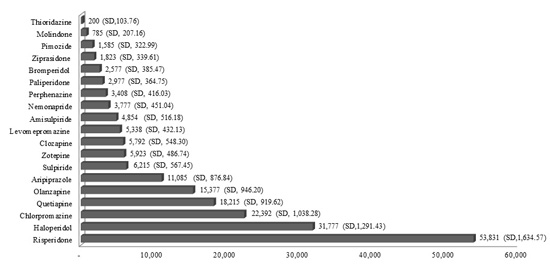1. Kwon JS, Kim ET, Ha TH, Roh KS, Choi JS, Kim YS. Drug prescribing patterns of outpatients with schizophrenia in a university hospital. J Korean Neuropsychiatr Assoc. 2003; 42:683–690.
2. Carpenter WT Jr, Davis JM. Another view of the history of antipsychotic drug discovery and development. Mol Psychiatry. 2012; 17:1168–1173.
3. Chong MY, Tan CH, Fujii S, Yang SY, Ungvari GS, Si T, Chung EK, Sim K, Tsang HY, Shinfuku N. Antipsychotic drug prescription for schizophrenia in East Asia: rationale for change. Psychiatry Clin Neurosci. 2004; 58:61–67.
4. Ahn YM, Kwon JS, Bahk WM, Kim CE, Park JI, Lee SY, Yi JS, Lee CH, Jang HS, Jun DI, et al. The feasibility test of Korean medication algorithm for the treatment with schizophrenic patients (II) : the problem for applying algorithm to the real clinical situation and opinion of revision. Korean J Psychopharmacol. 2006; 17:35–49.
5. Ahn YM, Lee HS, Kim YS, Kwon JS. Korean Medication Algorithm for Schizophrenia. In : Lee HS, editor. Clinical Neuropsychopharmacology. Seoul: ML Communications Co. Ltd.;2008. p. 731–742.
6. Choi HJ, Jung SH, Kang MH, Lee JS, Bae JN, Kim CE. Antipsychotics prescribing patterns of patients with schizophrenia admitted to Korean general hospital psychiatric unit: 2001 to 2008. Clin Psychopharmacol Neurosci. 2011; 9:17–22.
7. Shim IH, Woo YS, Jun TY, Kim KS, Bahk WM. Changes in antipsychotic drug usage in the psychiatric inpatients at a university hospital between 1997, 2003-2004 and 2009-2010. Korean J Psychopharmacol. 2012; 23:57–64.
8. Lee HJ, Lee TJ. Impact of price control on drug expenditure and factors associated with the drug switching among statins: analysis of HIRA-NPS data. Health Policy Manag. 2013; 23:112–123.
9. Ha JE, Bae JH. Reasons for extraction of permanent teeth in Korea. J Korean Acad Oral Health. 2012; 36:32–37.
10. Statistics Korea. Korean Standard Classification of Diseases. Seoul: Statistics Korea;2010.
11. World Health Organization. The ICD-10 classification of mental and behavioural disorders, clinical descriptions and diagnostic guidelines. Geneva: World Health Organization;1992.
13. Stahl SM. Dopamine system stabilizers, aripiprazole, and the next generation of antipsychotics, part 1, "Goldilocks" actions at dopamine receptors. J Clin Psychiatry. 2001; 62:841–842.
14. Tandon R, Belmaker RH, Gattaz WF, Lopez-Ibor JJ Jr, Okasha A, Singh B, Stein DJ, Olie JP, Fleischhacker WW, Moeller HJ. World Psychiatric Association Pharmacopsychiatry Section statement on comparative effectiveness of antipsychotics in the treatment of schizophrenia. Schizophr Res. 2008; 100:20–38.
15. Chang JG, Roh D, Kim CH. Recent trends of antipsychotics polypharmacy in schizophrenia. Korean J Psychopharmacol. 2013; 24:137–146.
16. Chung YK. Augmentation strategies for the treatment of schizophrenia. J Korean Soc Biol Psychiatry. 1998; 5:149–154.
17. Lieberman JA, Stroup TS, McEvoy JP, Swartz MS, Rosenheck RA, Perkins DO, Keefe RS, Davis SM, Davis CE, Lebowitz BD, et al. Effectiveness of antipsychotic drugs in patients with chronic schizophrenia. N Engl J Med. 2005; 353:1209–1223.
18. Koranek AM, Smith TL, Mican LM, Rascati KL. Impact of the CATIE trial on antipsychotic prescribing patterns at a state psychiatric facility. Schizophr Res. 2012; 137:137–140.
19. McEvoy JP, Lieberman JA, Stroup TS, Davis SM, Meltzer HY, Rosenheck RA, Swartz MS, Perkins DO, Keefe RS, Davis CE, et al. Effectiveness of clozapine versus olanzapine, quetiapine, and risperidone in patients with chronic schizophrenia who did not respond to prior atypical antipsychotic treatment. Am J Psychiatry. 2007; 163:600–610.
20. Lewis SW, Barnes TR, Davies L, Murray RM, Dunn G, Hayhurst KP, Markwick A, Lloyd H, Jones PB. Randomized controlled trial of effect of prescription of clozapine versus other second-generation antipsychotic drugs in resistant schizophrenia. Schizophr Bull. 2006; 32:715–723.
21. Xiang YT, Wang CY, Si TM, Lee EH, He YL, Ungvari GS, Chiu HF, Shinfuku N, Yang SY, Chong MY, et al. Clozapine use in schizophrenia: findings of the Research on Asia Psychotropic Prescription (REAP) studies from 2001 to 2009. Aust N Z J Psychiatry. 2011; 45:968–975.
22. Essock SM, Schooler NR, Stroup TS, McEvoy JP, Rojas I, Jackson C, Covell NH. Schizophrenia Trials Network. Effectiveness of switching from antipsychotic polypharmacy to monotherapy. Am J Psychiatry. 2011; 168:702–708.
23. Jones PB, Barnes TR, Davies L, Dunn G, Lloyd H, Hayhurst KP, Murray RM, Markwick A, Lewis SW. Randomized controlled trial of the effect on Quality of Life of second- vs first-generation antipsychotic drugs in schizophrenia: Cost Utility of the Latest Antipsychotic Drugs in Schizophrenia Study (CUtLASS 1). Arch Gen Psychiatry. 2006; 63:1079–1087.
24. Chang SM, Cho SJ, Jeon HJ, Hahm BJ, Lee HJ, Park JI, Cho MJ. Economic burden of schizophrenia in South Korea. J Korean Med Sci. 2008; 23:167–175.
25. Rosenheck RA, Leslie DL, Sindelar J, Miller EA, Lin H, Stroup TS, McEvoy J, Davis SM, Keefe RS, Swartz M, et al. Cost-effectiveness of second-generation antipsychotics and perphenazine in a randomized trial of treatment for chronic schizophrenia. Am J Psychiatry. 2006; 163:2080–2089.
26. Davies LM, Lewis S, Jones PB, Barnes TR, Gaughran F, Hayhurst K, Markwick A, Lloyd H. CUtLASS team. Cost-effectiveness of first- v. second-generation antipsychotic drugs: results from a randomised controlled trial in schizophrenia responding poorly to previous therapy. Br J Psychiatry. 2007; 191:14–42.
27. Yang J, Han C, Yoon HK, Pae CU, Kim MJ, Park SY, Ahn J. Experiences and barriers to implementation of clinical practice guideline for depression in Korea. BMC Psychiatry. 2013; 13:150.
28. Pilling S, Price K. Developing and implementing clinical guidelines: lessons from the NICE schizophrenia guideline. Epidemiol Psichiatr Soc. 2006; 15:109–116.
29. Hamann J, Ruppert A, Auby P, Pugner K, Kissling W. Antipsychotic prescribing patterns in Germany: a retrospective analysis using a large outpatient prescription database. Int Clin Psychopharmacol. 2003; 18:237–242.
30. Jeong HG, Lee MS. Long-acting injectable antipsychotics in first-episode schizophrenia. Clin Psychopharmacol Neurosci. 2013; 11:1–6.








 PDF
PDF ePub
ePub Citation
Citation Print
Print










 XML Download
XML Download